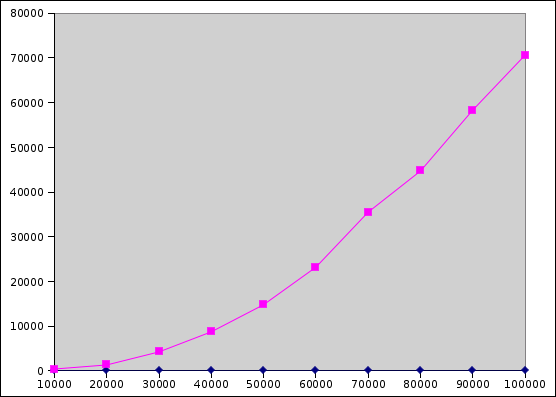Getting Started
Download CS201_Lab16.zip. Import it into Eclipse (File→Import…→Existing Projects into Workspace→Archive File.) You should see a project called CS201_Lab16 in the package explorer.
Your Task
Part 1 - Reversing a List using get and set
Implement the method called reverseUsingGetAndSet in the Reverse class. This method should reverse the elements of the List<E> object passed as the parameter by calling the get(int) and set(int, E) methods. A possible algorithm is suggested in the comment inside the method.
You can run the ReverseTest JUnit test class to test your implementation of the reverseUsingGetAndSet method.
Part 2 - Benchmark List reversal for ArrayList and LinkedList
Once the reverseUsingGetAndSet method is implemented, write a benchmark program which measures how long the reversal takes for both ArrayList<E> and LinkedList<E> objects with 10,000, 20,000, 30,000, etc. elements, up to and including 100,000 elements.
Add your benchmarking code to the Benchmark class. The main method is already partly implemented. You can call the createArrayList and createLinkedList methods to create array lists and linked lists with a specified number of elements.
Output each data point in the format
numElements,arrayListTime,linkedListTime
where times are measured in milliseconds. (See the description for Lab 12 for how to measure the execution time of a chunk of code. Don’t forget to call the System.gc() method before starting the timing, to avoid including garbage-collection overhead in your measurement.)
You should see output something like the following:
10000,12,442
20000,0,1352
30000,1,4270
40000,1,8759
50000,2,14825
60000,2,23214
70000,3,35525
80000,2,44721
90000,2,58349
100000,4,70634
Note that it will probably take a few minutes for the entire benchmark to complete.
Once you have collected your data, plot it in Excel. Your plot should look something like this:
Copy your Excel file into the Eclipse project. (Put it in the subdirectory of your Eclipse workspace called CS201_Lab16, and in Eclipse right-click on the project and choose Refresh.)
Submitting
Make sure that you have included your Excel file in the project!
When you are done, submit the lab to the Marmoset server using either of the methods below.
From Eclipse
If you have the Simple Marmoset Uploader Plugin installed, select the project (CS201_Lab16) in the package explorer and then press the blue up arrow button in the toolbar. Enter your Marmoset username and password when prompted.
From a web browser
Save the project (CS201_Lab16) to a zip file by right-clicking it and choosing
Export…→Archive File
Upload the saved zip file to the Marmoset server as lab16. The server URL is

